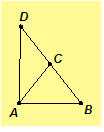Triangle Inequality![]()
![]() Printout
Printout
Proof is
the idol before whom the pure mathematician tortures himself.
—![]() Sir Arthur Eddington (1882–1944)
Sir Arthur Eddington (1882–1944)
On this page, we prove the Triangle Inequality based on neutral geometry results from Chapter 2.
Lemma. In a neutral geometry, if one angle is greater in measure than another angle of a triangle, then the opposite side of the greater angle is longer than the opposite side of the lessor angle. Furthermore, the longest side of a triangle is opposite the angle of greatest measure.
Proof.
Given .
Assume
Let A'
 be on ray
be on ray such that
Then
One of the following three is true: B is between C and A'; A' = B; or A'
is between C and B.
Case 1. Assume B is between C and A'. Then and by the
Exterior Angle Theorem
Thus
Hence
,
which contradicts the initial assumption. Hence B is not between C and A'.
Case 2. Assume A' = B. Then Hence
,
which contradicts the initial assumption.
By Cases 1 and 2, we must have A' between C and B. Hence, BC = BA'
+ A'C > A'C = AC. The cases for
the other pairs of sides may be proved similarly. Therefore, the longest side
of a triangle is opposite the angle of greatest measure.//
Triangle Inequality. In a neutral geometry, the length of one side of a triangle is strictly less than the sum of the lengths of the other two sides.
Proof. Given .
We prove
 one case here; the other cases are similar. Let D be on ray
one case here; the other cases are similar. Let D be on ray such that C
is between B and D and
Since
is an isosceles triangle,
Since C
is between B and D and
,
,
by the Angle Addition Postulate. Hence
By the Lemma, BD > BA. Therefore,
since C is between B and D, AC + CB = DC + CB = DB > BA. Since the proofs of the other two cases are similar, the length
of one side of a triangle is strictly less than the sum of the lengths of the
other two sides.//